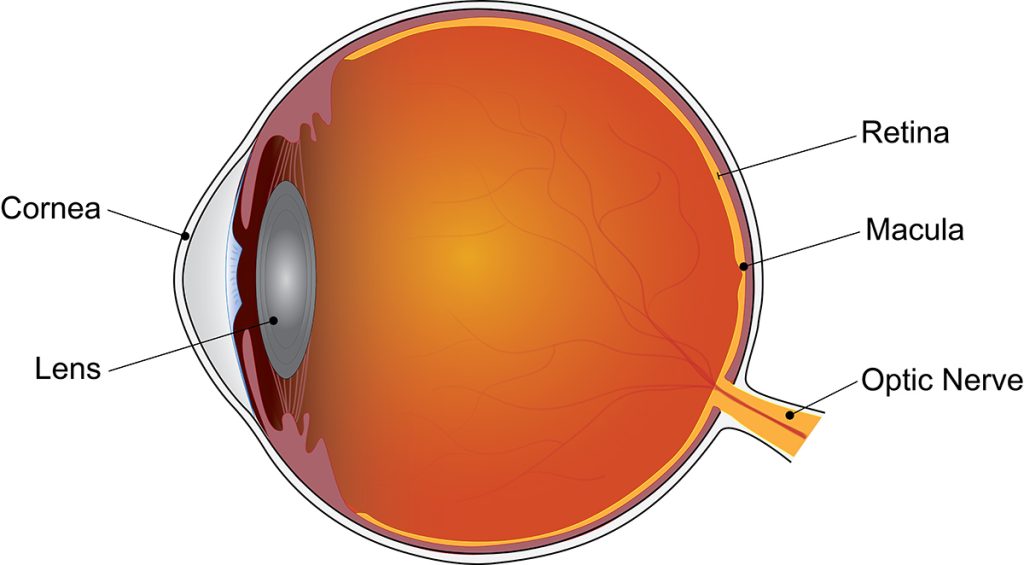news release
Tuesday, July 16, 2024
A new analysis shows the benefit of taking the AREDS2 regimen in patients with late-stage AMD.
In a new data analysis, researchers at the National Institutes of Health (NIH) have found that taking a daily supplement containing antioxidant vitamins and minerals may slow the progression of end-stage dry age-related macular degeneration (AMD) and allow patients with the end-stage disease to preserve central vision. The researchers reviewed retinal scans of participants in the Age-Related Eye Disease Studies (AREDS and AREDS2) and found that patients with end-stage dry AMD who took antioxidant supplements slowed the expansion of the area of geographic atrophy toward the foveal region of the retina. The study was published in the journal Ophthalmology.
“We have known for some time that AREDS2 supplementation can help slow the progression of intermediate to late AMD, and our analysis shows that taking AREDS2 supplementation can also slow disease progression in patients with late-stage dry AMD,” said Tiernan Keenan, M.D., Ph.D., of NIH’s National Eye Institute (NEI) and lead author of the study. “These results support the continued use of AREDS2 supplementation for patients with late-stage dry AMD.”
In the new analysis, the researchers reexamined the original retinal scans of participants from the AREDS (318 participants, 392 eyes in total) and AREDS2 (891 participants, 1210 eyes in total) trials who developed atrophic AMD and calculated the location and rate of spread of areas of geographic atrophy. For those who developed geographic atrophy in the central field, the supplement had little effect. However, for the majority of people who developed geographic atrophy far from the fovea, the supplement slowed the rate of spread to the fovea by about 55% over an average of three years.
In early and intermediate AMD, small yellow deposits of fatty proteins called drusen form on the light-sensing retina at the back of the eye. As the disease progresses to later stages, blood vessels may become leaky (“wet” AMD) and some of the light-sensing cells in the retina may be lost (“dry” AMD). The geographic atrophy in these areas slowly increases over time, causing a gradual loss of central vision.
of Original AREDS study Taking supplements containing antioxidants (vitamins C, E, and beta-carotene), zinc, and copper has been shown to slow the progression of mid- to late-stage AMD. Subsequent AREDS2 trial Substituting the antioxidants lutein and zeaxanthin for beta-carotene was found to improve the efficacy of the supplements and eliminate certain risks. At the time, neither trial detected any additional benefits once participants were in the later stages of the disease.
However, this initial analysis did not take into account a phenomenon called “foveal sparing” in the dry form of late AMD. All areas of the retina are sensitive to light, but the area where central vision is most acute is called the fovea. Many patients with dry AMD first develop geographic atrophy outside this foveal area and only lose central vision when the area of geographic atrophy spreads into the foveal area.
“Our high acuity central vision is essential for tasks such as reading and driving. Given that end-stage dry AMD patients have few treatment options to preserve or restore their vision, antioxidant supplementation is a simple step that can slow the decline of central vision, even in end-stage patients,” Keenan said. “We plan to confirm these findings in a dedicated clinical trial in the near future.”
Learn more about AREDS and AREDS2
Study authors include Keenan, Elvira Agrón and Emily Chew, MD, PhD, of NEI; Pearse Keane, MD, PhD, of Moorfields Eye Hospital in the UK; and Amitha Domalpally, MD, PhD, of the University of Wisconsin-Madison. This research was supported by the NEI Intramural Research Program. Funding for the AREDS and AREDS2 studies was provided by NEI and the NIH Office of Dietary Supplements, National Center for Complementary and Alternative Medicine, National Institute on Aging, National Heart, Lung and Blood Institute, and National Institute of Neurological Disorders and Stroke under contract numbers NOI-EY-0-2127, HHS-N-260-2005-00007-C, and N01-EY-5-0007. The AREDS and AREDS2 studies (clinicaltrials.gov numbers NCT00000145 and NCT00345176, respectively) were conducted at the NIH Clinical Center.
About the National Institutes of Health (NIH):NIH is the nation’s medical research agency, comprised of 27 Institutes and Centers, and is part of the U.S. Department of Health and Human Services. NIH is the primary federal agency conducting and supporting basic, clinical, and translational medical research, investigating the causes, treatments, and cures for both common and rare diseases. For more information about NIH and its programs, visit: Click here for details.
NIH…Transforming Discovery into Health®
reference
Keenan TDL, Agron E, Keane PA, Domalpally A, Chew EY, AREDS and AREDS2 Study Group. “Oral antioxidant and lutein/zeaxanthin supplements slow progression of geographic atrophy to the fovea in age-related macular degeneration.” Ophthalmology. Electronic publication July 16, 2024. doi: 10.1016/j.ophtha.2024.07.014


